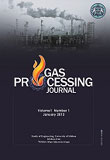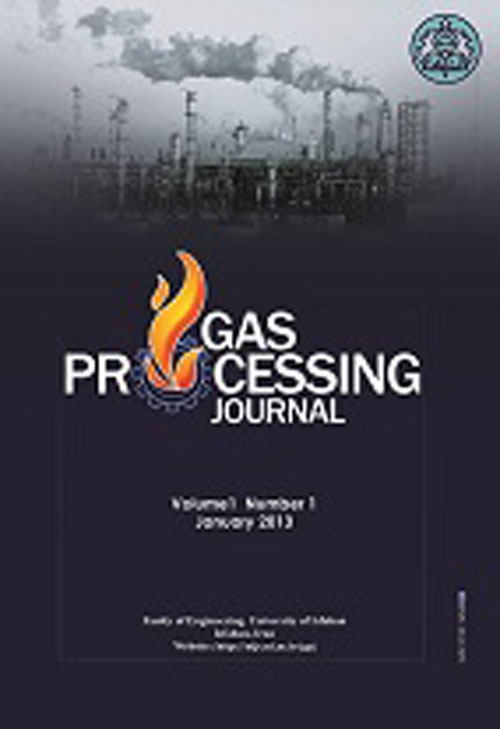فهرست مطالب

Gas Processing Journal
Volume:8 Issue: 1, Winter 2020
- تاریخ انتشار: 1399/03/12
- تعداد عناوین: 6
-
-
Pages 1-16Due to the necessity of using highly efficient power generation systems to reduce fuel consumption and air pollution, the integration of different energy systems is promising modification to achieve higher efficiency. In this paper, the integration of an Internal Reforming Solid Oxide Fuel Cell (IRSOFC)-Gas Turbine (GT)-Organic Rankine Cycle (ORC) system has been proposed. In this regard, thermodynamic modeling and simulation of the proposed system have been done to evaluate the performance of the integrated system. Also, exergetic, exergoeconomic and advanced exergetic analysis has been performed for the proposed system. The analysis of the integrated system has been carried out by using MATLAB code. Verification of thermodynamic simulation has been performed with high accuracy. Results of thermodynamic simulation show that the net power and overall cycle efficiency of the proposed cycle are increased by 1.1 MW and 7.7 % respectively rather initial SOFC-GT combination. The exergy analysis indicated that exergy efficiency is 40.95%, for the proposed system and 37.3% for the initial base case. As a result, the exergy destruction, exergoeconomic factor, cost rate per exergy unit of product and fuel, and cost rate associated with the exergy destruction for each component are calculated and evaluated. Also, endogenous/exogenous and avoidable/unavoidable parts of exergy destruction, exergy destruction costs, and capital costs have been determined and compared.Keywords: solid oxide fuel cell, gas turbine, Organic RankineCycle, Exergy, Advanced exergy analysis
-
Pages 17-36In this study, an integrated structure of the air separation unit, natural gas liquids recovery equipped with nitrogen removal unit is developed. In this regard, advanced exergy and exergoeconomic analyses are used to examine the irreversibility, possible improvements and the cost of the inefficiencies of the process. The exergy analysis presents information on the origin of the irreversibility as well as the amount of irreversibility of each component. The results of advanced exergy analysis show that HX2, HX3, C1, C2, C3, AC1, AC3 equipment have the highest amount of the irreversibility due to endogenous exergy destruction, whereas the highest amount of the irreversibility in the rest of the equipment is because of exogenous exergy destruction. Furthermore, avoidable exergy destruction of equipment is more than the unavoidable exergy destruction in the C1, C2, and C3. This issue shows that with the improvement of the efficiency of the equipment, it is feasible to reduce the irreversibility of these systems. In addition, the results of advanced exergoeconomic analysis show that the priority to improve the performance of the system should be devoted to the HX2, HX3, C1, C3, AC1, AC3 equipment, respectively. The AC1 air cooler and the C3 compressor have the highest amounts of investment cost of avoidable endogenous exergy destruction, respectively. The heat exchanger HX3 and air cooler AC2 and AC3 have the lowest investment cost of avoidable endogenous exergy destruction.Keywords: Natural gas liquids, non-standard nitrogen separation, air separation unit, Advanced exergy analysis, Advanced exergoeconomic analysis
-
Pages 37-48Simulation and Computational Fluid Dynamic (CFD) analyses of condensing shell and tube heat exchanger is subjected in this article. The condensing model using a User Defined Function (UDF) through Ansys Fluent 18.2 is developed. Also, the heat transfer between the shell and tube bundles is considered too. The subjected heat exchanger included seven tubes with a length of 600 mm and a shell with a diameter of 90 mm. The effect of different types of baffles and the distance between them is investigated in this article. All the calculations were done in three different mass flow rates. Finally, the distribution of heat flow is depicted for each stage of the considered heat exchanger. Results show that for the specific geometry and constant distance between baffles, increment in the mass flow rate leads to increasing the heat transfer coefficient. In addition, it shows that the formation of dew droplets and condensed water is higher in the first geometry due to the maximum heat transfer by hot flue gas.Keywords: Condensing Shell, Tube Heat Exchanger, UDF functions, Ansys Fluent 18.2, Baffles, Heat transfer coefficient
-
Pages 49-68The sharp seasonal fluctuations in gas consumption in the domestic sector and prioritizing this segment have led to serious gas supply problems in other subdivisions, such as power plants during cool seasons. One of the approaches presented in this field is storing liquefied natural gas in warm seasons and using it during the colder seasons to supply the power required for power plants. In this regard, processes were selected based on the capacity required for storing liquefaction units over a 200-day period for a commonly combined cycle power plant with a power generating capacity of 332 MW. In this study, the simple expanders – nitrogen and two expander – nitrogen liquefaction processes have been evaluated. Changes in environmental and operating conditions (such as changes in discharge, pressure, temperature, and composition percentage of natural feed gas components) are problems that peak shaving units will face permanently. As a result, low sensitivity to changing conditions is one of the important criteria in choosing the right process. In this study, the dimensionless sensitivity analysis method was used to study the behavior of liquefaction cycles. The results show that the simple expander – nitrogen process has a higher power consumption. The sensitivity to changing environmental and operating conditions for the two-expander process is 70% lower than that of the simple expander – nitrogen process. Also, the uncertainty in power consumption overall values is 2.58% for the simple expander – nitrogen process and 1.14% for two expander – nitrogen process.Keywords: Simple Expander – Nitrogen Process_Two Expander – Nitrogen Process_Sensitive Analysis_Environmental_Operating Conditions
-
Pages 69-82Gas turbine inlet air is filtered in multiple steps. First, the filtration step is used for removing the big things. Then, Sand and dust are removed using the inertial sand separators. Sand separators filtration system is composed of 30 rows of the inertial sand separators on 5 floors. In this paper, one floor of the inertial sand separators filtration system of Shahid Kave power plant has been simulated using Ansys Fluent 16. A computational server with 20 processing cores and RAM of 120 GB was used to carry out the calculations. The velocity and pressure fields have been studied and the effect of density and diameter of particles on inertial sand separators efficiency are investigated. Particle diameter and density are varied between 0.1 to 100 micrometer and 500 to 2000 kg/m3 respectively. The result shows that the collection efficiency of the inertial sand separators was reduced by increasing the particle diameter. However, the collection efficiency of the inertial sand separators was improved by increasing the particle density. Also, a few particles are collected by inertial sand separators, so that collection efficiency is less than 1%. Therefore, this system is inefficient and not cost-effective and elimination of the system fans could reduce the energy consumption of the gas power plant around 360 kW.Keywords: Particles separation, Turbulence flow, Discrete phase, Collection Efficiency
-
Pages 83-92A key variable for determining carbon dioxide (CO2) storage capacity in sub-surface reservoirs is the interfacial tension (IFT) between formation water (brine) and injected gas. Establishing efficient and precise models for estimating CO2 – brine IFT from measurements of independent variables is essential. This is the case, because laboratory techniques for determining IFT are time-consuming, costly and require complex interpretation methods. For the datasets used in the current study, correlation coefficients between the input variables and measured IFT suggests that CO2 density and pressure are the most influential variables, whereas brine density is the least influential. Six artificial neural network configurations are developed and evaluated to determine their relative accuracy in predicting CO2 – brine IFT. Three models involve multilayer perceptron (MLP) tuned with Levenberg-Marquardt, Bayesian regularization and scaled conjugate gradient back-propagation algorithms, respectively. Three models involve the radial basis function (RBF) trained with particle swarm optimization, differential evolution and farmland fertility optimization algorithms, respectively. The six models all generate CO2 – brine IFT predictions with high accuracy (RMSEKeywords: Interfacial Tension (IFT), CO2 Storage, Multi-layer perceptron, Radial basis function, Neural Network Prediction, IFT Influencing Variables


